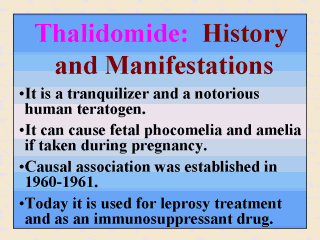 |
Thalidomide is a
tranquilizer as well as a notorious human teratogen, not a disease. This teratogen was
associated with perhaps the most publicized birth defects tragedy of the last century,
especially of the 1960s. A teratogen is an agent that can cause fetal malformations or
monstrosities. Introduced in 1956 in West Germany, thalidomide soon became a drug
prescribed to many pregnant women for the treatment of morning sickness. Yet it also soon
became clear that when used by pregnant women during the first trimester, this drug would
impair the proper growth of the fetus causing a very rare and characteristic limb
deformity such as amelia (absence of the limbs) and phocomelia (absence/reduction of the
proximal portion of the limbs). Congenital heart disease and other typical anomalies may
also result. The thousands of children born with these deformities in the late 1950s and
early 1960s became known as Thalidomide babies. Historically, the suspicion that
thalidomide was the teratogen was not launched by academic epidemiologists, but by several
German and Australian clinicians who noticed several limb deformity cases that were rarely
seen before the late 1950s. Thalidomide was withdrawn from the world market at the end of
1961, shortly after the causal association was established. The drug did not receive
marketing approval in the USA during this epidemic. Today, thalidomide is approved for use
in the USA for the treatment of erythema nodosum in leprosy. It is also being tested as an
immunosuppressant drug including for the treatment of AIDS. |
